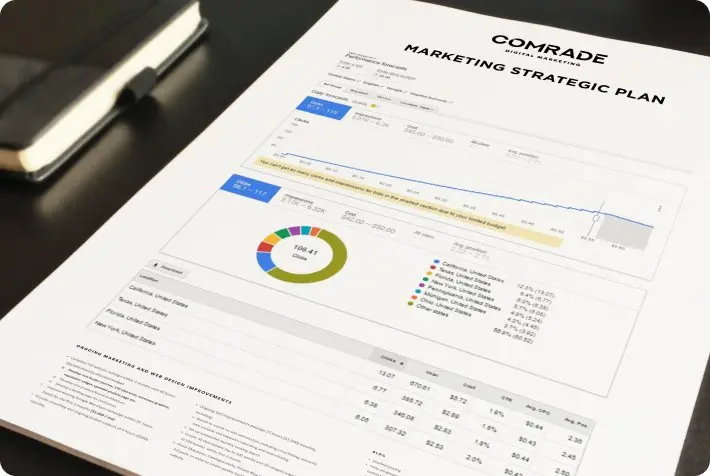The roofing industry is a vital part of construction, providing essential protection for homes and businesses alike. With billions of dollars at stake, it’s a dynamic field that’s constantly evolving to meet new challenges and demands.
From cutting-edge materials to a growing focus on sustainability, roofing is changing in exciting ways. The industry is navigating new opportunities and hurdles that are shaping its future.
In this article, we’ll dive into 35 eye-opening roofing industry statistics, giving you a closer look at trends, growth drivers, and what’s coming next. Whether you’re in the business or just curious, these insights offer a fresh perspective on the future of roofing.

Roofing Industry Dynamics and Economic Footprint

1. North America Dominates the Roofing Market
Source: Allied
North America represents 31% of the global roofing market and is expected to reach $41 billion by 2031, growing at an annual rate of 4.9%. This dominance highlights North America’s central role in the global roofing industry, with steady demand for roof replacements and innovative solutions like solar roofing. The region’s growth reflects a strong economic foundation for roofing businesses to capitalize on.
2. U.S. Residential Roofing Market on Track for $15 Billion by 2030
Source: MMR
The U.S. residential roofing market is set to grow from $10.84 billion in 2023 to $15 billion by 2030. This surge in market size indicates a significant increase in residential roof replacements and upgrades, driven by aging infrastructure and climate-related repairs. Roofing companies specializing in residential services will find ample opportunity in this growing sector.
3. Asphalt-Shingle Replacement Costs Soar
Source: HomeAdvisor 2025 Cost Guide
The typical cost of replacing an asphalt shingle roof in 2025 ranges from $5,000 to $10,000 per home. This price range reflects both the material costs and labor required for high-quality roof replacements. As the cost of roofing rises, homeowners may seek more affordable options or additional financing, opening opportunities for businesses that can offer flexible solutions.
4. New Roof Yields Up to 110% ROI
Source: NAR Remodeling Impact Report 2025
Replacing a roof can generate up to 110% return on investment (ROI) when selling a home. This high ROI demonstrates how roofing improvements are seen as valuable investments in home sales. Roofers can use this information to highlight the financial benefits of roof upgrades to potential clients, positioning their services as an investment rather than an expense.
Insights into the Roofing Workforce
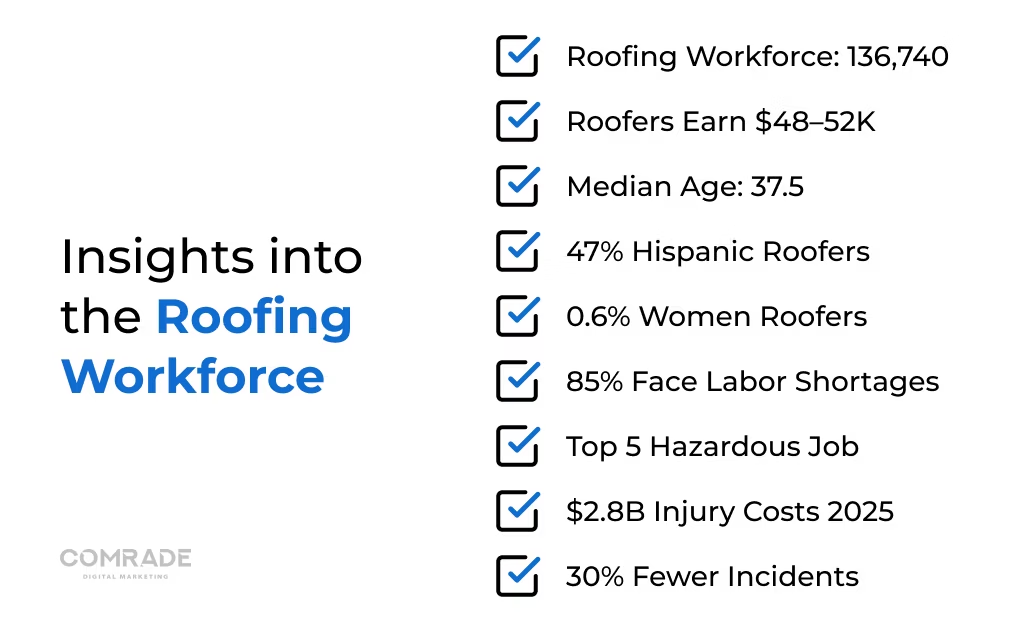
5. Roofing Workforce Hits 136,740 in the U.S.
Source: US BLS
There are approximately 136,740 roofers employed across the U.S. in 2024. This reflects a large and essential workforce serving the roofing needs of homeowners and businesses nationwide. As the market grows, demand for skilled labor will continue to rise, and roofing companies will need to focus on talent retention and recruitment.
6. Roofers Earn $48K–$52K Annually
Source: US BLS
The median pay for U.S. roofers ranges from $48,000 to $52,000 per year. This competitive salary reflects the skills required for roofing jobs, along with the industry’s increasing reliance on experienced workers. Roofing companies can attract and retain top talent by offering solid wages and career advancement opportunities.
7. Median Age of Roofers: 37.5 Years Old
Source: CSCE
The median age of a roofer is 37.5 years old, indicating a well-established workforce with a mix of experience and longevity. As the industry sees growth, companies must ensure they create training and recruitment pipelines to bring in younger workers to balance the aging workforce and prepare for future needs.
8. 47% of Roofers Are Hispanic
Source: CSCE
Nearly 47% of roofers in the U.S. are Hispanic, reflecting the diverse makeup of the roofing workforce. This highlights the significant contribution of Hispanic workers to the roofing industry and emphasizes the need for inclusive work environments that recognize and support this demographic.
9. Only 0.6% of Roofers Are Women
Source: CSCE
Women represent just 0.6% of roofers in the U.S., showing a stark gender disparity in the workforce. Roofing companies could benefit from targeted recruitment efforts and workplace culture changes that encourage more female participation and provide career opportunities for women in the industry.
10. 85% of Contractors Struggle with Skilled-Labor Shortages
Source: NRCA 2024 Labor Survey
A staggering 85% of contractors report that they are facing skilled-labor shortages in 2024. This ongoing challenge highlights the need for more training programs and strategies to attract new talent to the industry, especially as demand for roofing services continues to increase.
11. Roofing is Among the Top 5 Most Hazardous Jobs
Source: US BLS
Roofing remains one of the Top 5 most hazardous jobs, with fatality rates around 50 deaths per 100,000 workers. The high-risk nature of the job necessitates strict safety protocols and a culture of safety within roofing companies to reduce accidents and fatalities in the workforce.
12. Roofing Injuries Projected to Cost $2.8 Billion by 2025
Source: OSHA 2025 Construction Safety Outlook
Injuries related to roofing are projected to cost the industry $2.8 billion by 2025. This staggering cost highlights the economic impact of workplace accidents and the urgent need for roofing companies to prioritize safety measures and training to prevent accidents and reduce financial losses.
13. Enhanced Safety Training Leads to 30% Fewer Incidents
Source: National Safety Council 2024 Study
Roofing companies with enhanced safety training programs see 30% fewer incidents compared to those without. This statistic illustrates that investing in safety education not only protects workers but also improves operational efficiency by reducing downtime caused by accidents. Roofing companies should integrate comprehensive safety programs into their daily operations to safeguard both workers and profits.
Key Drivers and Obstacles in the Roofing Market
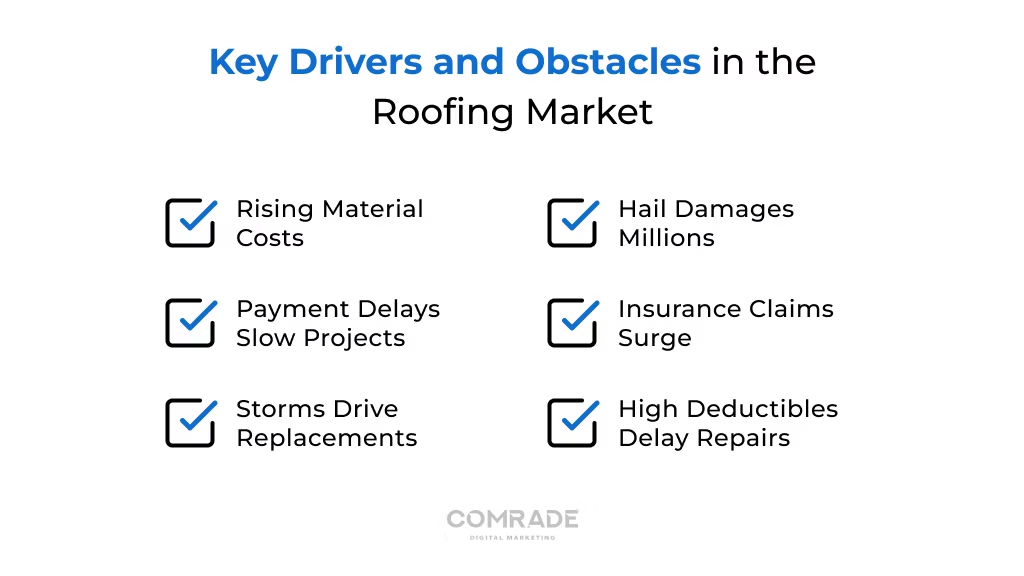
14. Rising Material Costs Squeeze Roofing Contractors
Source: Roofing Contractor
42% of roofers express concern about rising material costs. With inflation affecting the cost of shingles, underlayment, and other essential materials, contractors are under pressure to adjust pricing or absorb the increased expenses. Strategic supplier relationships and alternative materials might become key to staying profitable.
15. Payment Delays Stall Roofing Projects
Source: Rabbet
37% of subcontractors report that payment delays have caused halts in roofing projects. Cash flow issues can cripple contractors and delay completion times, leading to dissatisfied clients and a strained reputation. Roofing businesses may need to implement clearer payment terms and enforce stricter agreements to mitigate this challenge.
16. Storm Damage Drives Significant Roof Replacements
Source: Insurance Information Institute, Annual Weather Report 2024
22% of residential roof replacements in 2024 are due to storm damage. This indicates a strong connection between extreme weather events and increased demand for roofing services. Roofers in storm-prone areas should prepare for spikes in business, particularly after heavy storms, by having resources and teams ready for emergency repairs and replacements.
17. Hail Damage Affects Millions of U.S. Homes
Source: NOAA 2024 Severe Weather Report
In 2024, 12 million+ U.S. properties were affected by hail damage. This widespread issue results in a surge of insurance claims and replacement jobs for roofing contractors. Roofers in areas frequently impacted by hailstorms should prepare for a high volume of claims and take advantage of the growing demand for repairs.
18. Insurance Claims Surge After Severe Storms
Source: Insurance Information Institute 2024 Analysis
After severe storms, roof-related insurance claims increase by 65% within nine months. This shows the significant impact that extreme weather events have on roofing businesses. Roofers can capitalize on this trend by being proactive with marketing to homeowners post-storm, offering fast and reliable services for those filing claims.
19. High Deductibles Cause Homeowners to Delay Repairs
Source: Consumer Federation of America, 2024 Study
35% of homeowners delay roof repairs because of high deductibles. Despite recognizing damage, many homeowners are hesitant to move forward with repairs due to the out-of-pocket cost. Roofers may need to provide financing options or work with insurance companies to help homeowners cover repair costs more efficiently.

Roofing Industry Marketing Insights and Stats

20. Roofing Ads: High Cost, Modest Click-Through Rate
Source: LocaliQ
Roofing ads have a CPC of $11.13 with a CTR of 3.85%. While the cost-per-click is relatively high, the click-through rate shows that online ads are still driving valuable traffic to roofing websites. Contractors should ensure their ads are well-targeted to maximize ROI and consider optimizing their campaigns to boost conversions.
21. Roofing Companies Struggle with SEO
Source: RoofingWebMasters
A significant 70% of roofing companies report being dissatisfied with their SEO performance. Despite the digital landscape being a major marketing tool, many roofers are falling short in optimizing their websites for search engines. Improving SEO strategies is essential for driving more organic traffic and attracting local customers.
22. AI is Still Underutilized in Roofing Marketing
Source: RoofingWebMasters
Less than 30% of roofers are using AI in their marketing efforts. AI can help roofers target the right customers more effectively and automate various aspects of their campaigns. As the technology advances, more roofers are likely to embrace AI to enhance their digital marketing strategies.
23. Augmented Reality (AR) Boosts Roofing Sales
Source: Angi Roofing Technology Survey 2024
The use of augmented-reality tools has been shown to shorten sales cycles by 42%. By allowing potential customers to visualize roofing options in real-time, AR is enhancing customer experience and speeding up decision-making. Roofers adopting AR could see faster conversions and higher satisfaction rates.
24. Remote Estimates: A Growing Trend for Roofers
Source: NRCA State of the Industry 2024
Around 26% of roofing businesses now offer virtual/remote estimates. This trend reflects the growing demand for convenience and digital engagement among homeowners. Roofers who provide remote estimates are more likely to attract tech-savvy clients and stay ahead of the competition in a changing market.
The Behavior and Preferences of Roofing Customers
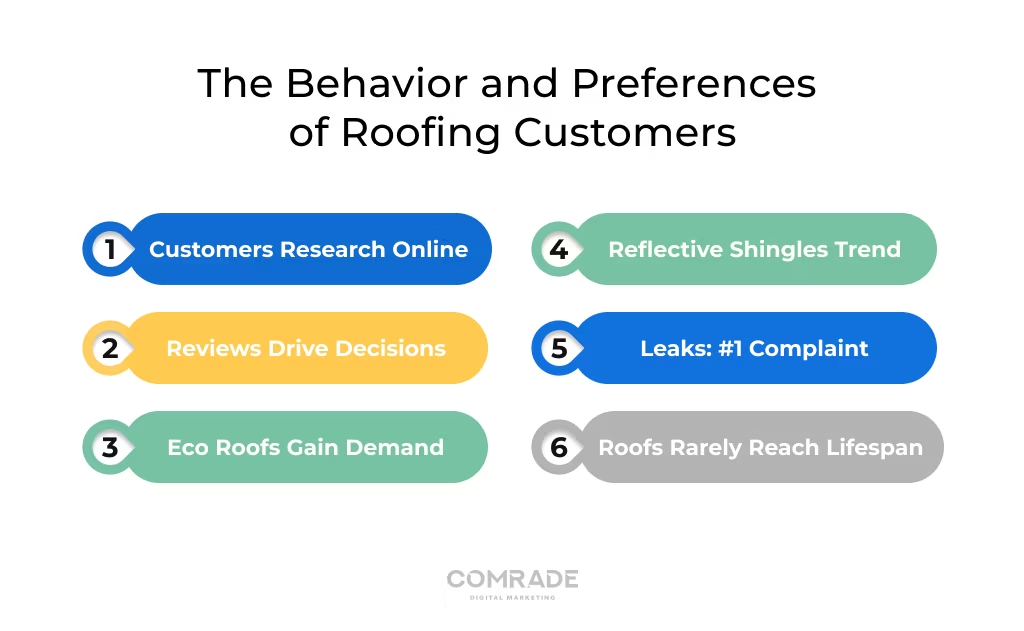
25. Customers Research Roofing Services Online
Source: Brightlocal
29% of customers read online reviews before booking a roofing service, and over 55% research online first. This statistic highlights the growing importance of a strong online presence for roofers. With many homeowners turning to the internet for reviews and information, having positive feedback and detailed online profiles is key to gaining trust and securing jobs.
26. Online Reviews Influence Roofing Decisions
Source: BrightLocal Local Consumer Review Survey 2024
35% of homeowners say online reviews are their top factor when choosing a roofer. This statistic emphasizes how vital customer feedback is in shaping a roofer’s reputation. Roofers must actively manage their online presence and solicit reviews to build credibility and attract more clients.
27. Homeowners Are Willing to Pay More for Eco-Friendly Roofs
Source: Green Builder Media, Residential Eco Report 2024
45% of homeowners are willing to pay a 10–15% premium for eco-friendly roofing. As sustainability continues to influence consumer choices, roofers offering green roofing options can attract environmentally conscious clients. Highlighting the environmental benefits of certain roofing materials could help contractors stand out in a competitive market.
28. Reflective Roofing Shingles Gain Popularity
Source: CertainTeed Consumer Insights 2024
42% of homeowners are considering reflective “cool” shingles for their next roof. These energy-efficient options are becoming more attractive as homeowners look to reduce energy bills and improve sustainability. Roofers should be prepared to discuss the benefits of cool roofing materials with clients looking for environmentally friendly alternatives.
29. Leaks Remain the Top Roofing Complaint
Source: BBB
40% of roofing complaints are related to leaks. This statistic highlights a critical pain point in the roofing industry, making it clear that leak prevention and repair services are in high demand. Roofers should ensure they emphasize the quality and durability of their work to prevent issues with leaks and customer dissatisfaction.
30. Roofs Can Last a Lifetime — But Many Don’t
Source: Nationwide
Most roofs last between 12 to 50 years, depending on the materials used. For instance, asphalt shingles typically last 15-30 years, while metal roofs can last up to 50 years. Homeowners should consider the long-term investment in roofing materials based on their durability and the climate of their region.
Emerging Trends Influencing the Roofing Market
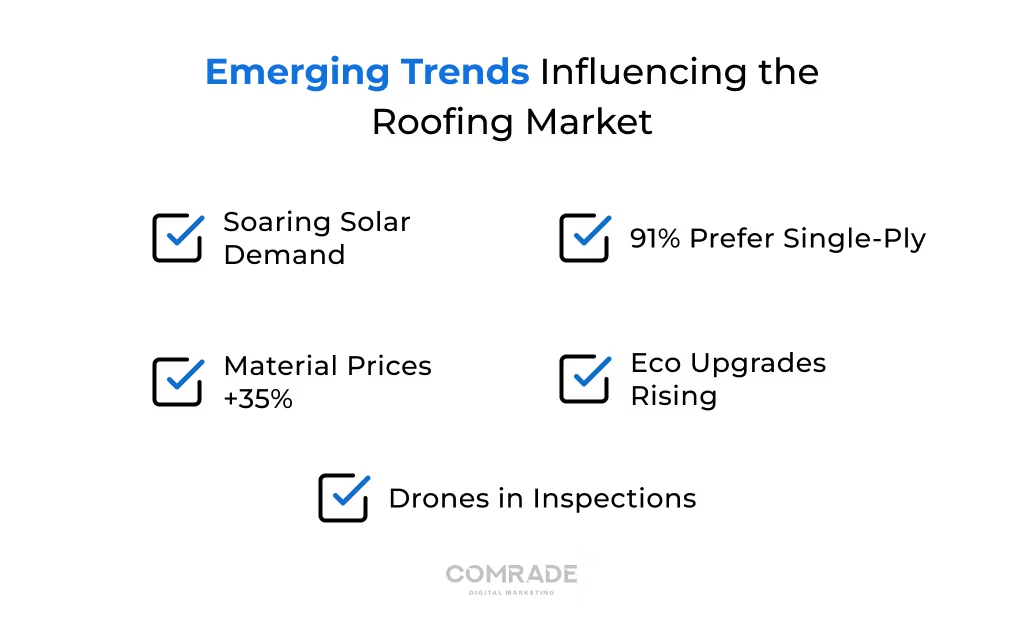
31. Demand for Solar Roofing Materials Soars
Source: PRNewswire
The demand for solar roofing materials is increasing by 15% annually. As energy efficiency and sustainability become top priorities for homeowners and businesses, solar roofing presents an attractive option. Roofing companies can capitalize on this trend by offering solar-integrated roofs, driving both environmental benefits and long-term cost savings for clients.
32. Material Prices Up 35% Compared to 2020
Source: Cladco
Since 2020, material costs have surged by 35%, driven by inflation and supply chain disruptions. This price increase is forcing roofers to adjust their pricing strategies and look for cost-effective materials without sacrificing quality. Contractors may need to become more resourceful in sourcing materials and managing client expectations to maintain profitability.
33. Single-Ply Roofing Systems Favored by 91% of Commercial Roofers
Source: BBB
Single-ply roofing systems like TPO, EPDM, and PVC dominate the commercial roofing sector, with 91% of contractors choosing them for their combination of durability, affordability, and energy efficiency. These systems have emerged as the standard for commercial projects, making them a smart focus for roofing companies aiming to stay competitive in a market where sustainability and longevity are top priorities.
34. Eco-Friendly Home Improvement Sales Are on the Rise
Source: JLC
Eco-driven home-improvement sales are increasing by about 4% each year. As sustainability becomes a core value for homeowners, the demand for energy-efficient roofing materials and green solutions is on the rise. Roofing contractors who focus on eco-friendly materials and solutions will likely see greater demand in the coming years.
35. Drone Usage in Roofing Inspections Expand
Source: BBB
Around 20% of contractors are already using drones for inspections or measurements. This technology allows for more accurate, safer, and faster assessments of roofing projects. As drone technology improves, its widespread adoption can enhance efficiency and reduce risks in roofing businesses.
Roofing Success Begins with the Right Strategy
The roofing industry is constantly evolving, with new trends and customer expectations shaping the market. These 35 key statistics show just how important it is to stay ahead of the competition.
At Comrade Digital Marketing, we’re experts in helping roofing companies thrive in today’s digital world. Whether it’s generating more leads or boosting your online presence, we understand what it takes to make your brand shine.
Want to see real growth for your roofing business? Reach out to us today, and let’s work together to take your business to new heights.

